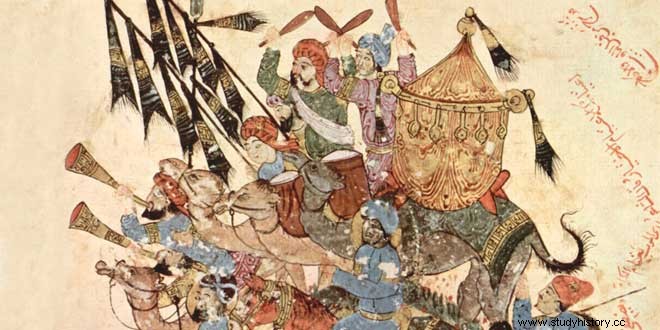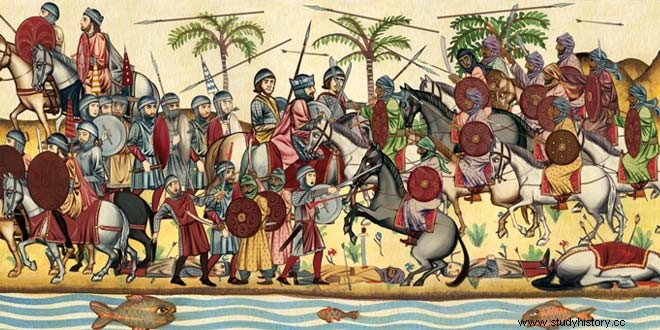Rodrigo was a Visigoth king who ruled from 710-711. He was the son of Teodofredo (son of King Chindasvinto), and Count of Baetica. In the civil war that followed Witiza's death, his supporters defeated him and elected him king after overthrowing Agila II . The history of this king is very short, because his reign was short, only one year; but the legends around him and his end are endless; Leaving these aside, the Visigothic kingdom ended as follows:the Muslims had spread throughout North Africa, and threatened the city of Ceuta, which had belonged to the Visigoths since the reign of Suintila; The governor of Ceuta was Olbán, a Catholic Berber (called Count Julián for the first time at the end of the 11th century by a monk from Silos), a friend of Witiza, who supplied him with reinforcements and provisions, since the security of the Ceuta square was of interest. much to the Visigoths, for being a strategic point for the defense of the Strait of Gibraltar against a possible invasion of Islam towards the Iberian Peninsula.
AlliancewithMuslims
During the civil war that followed the death of Witiza, the Visigoths did not bother to continue supplying aid to Ceuta, where, once dethroned, Agila II went with his brothers Olmundo and Ardabasto in search of refuge. There, in agreement with Olbán, they conceived a plan to overthrow King Rodrigo with the help of the Muslims, which Olbán negotiated with Muza ibn Nusayr (Muslim governor of North Africa), through Tarik ibn Ziyad (governor of Tangier).; Olbán promised to submit to the Muslims and facilitate their passage to the Iberian Peninsula in exchange for being allowed to remain in the government of Ceuta .

Muslim expedition
Knowing Muza the problems in which the Visigothic kingdom was, he sent the Berber freedman Tarif Abu Zara with 300 infantry and 100 horsemen in July of the year 710, to explore the coastal area near the Strait of Gibraltar ;
These 400 men, helped by Count Julián and his Witizian friends, crossed the Strait in four ships and arrived at the place that they later called Tarifa (in honor of his boss). They made a quick foray as far as Algeciras and returned to Africa with considerable loot.
Muslim invasion
In view of the information and loot obtained by these 400 expeditionaries, Muza sent, in the spring of the year 711, another expedition commanded by his lieutenant Tariq ibn Ziyad, a Persian from Hamadan converted to Islam, who was governor of Tangier; he crossed the Strait of Gibraltar with 7,000 Berber men and freedmen (among them there were only about fifty Arabs). This army reached the foothills of Mount Calpe, which he called Jabal Tariq ( “mountain of Tariq” or Gibraltar) in honor of their chief; from this place the 7,000 went to Algeciras and conquered it. Immediately they joined combat with Bencio, nephew of King Rodrigo whom they defeated and killed; a nobleman named Wiliesindo ran to communicate the news of the Muslim invasion to King Rodrigo, who was suppressing an uprising by the Vascones. Rodrigo quickly undertook the road to the south of his kingdom, to meet the invader; he led an army of about 100,000 men; so Tariq asked Muza for reinforcements, who sent another 5,000 Berber infantry . With this army of 12,000 men, Tariq faced Rodrigo's army on July 19, 711, the fight lasted until the next day; the decisive battle took place along the Guadalete river between Medina-sidonia and the Janda lake. King Rodrigo commanded the center of the army, and entrusted the command of the wings to two brothers of the late King Witiza (Silberto and Oppas); they abandoned their posts and went to help the invaders. Rodrigo's army fought bravely, but by the time they realized Tariq's intentions, it was too late; the state had death with its king Rodrigo.
We have seen that, in the reign of Wamba (672-680), the Muslims tried, for the first time, to invade the Iberian Peninsula; but the army of this king prevented him:he defeated them and burned 270 ships. Nor in the year 711 would they have been able to invade the Visigoth kingdom with 12,000 men if King Rodrigo with his army of 100,000 men had not had to be at the other end of his kingdom suppressing the aforementioned rebellion; This, more than Count Julián and the Witizians, facilitated and was the cause (albeit inadvertently) of said invasion of the Iberian Peninsula by Islam in the year 711.

